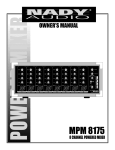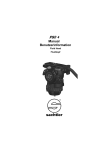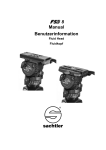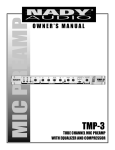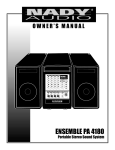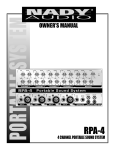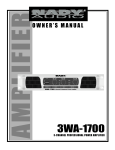Download Nady Systems 150 User's Manual
Transcript
OWNER’S MANUAL Portable Sound System 150 PORTABLE SOUND SYSTEM 150 Congratulations on your choice of a portable sound system — you have purchased one of the finest portable sound systems on the market today. This unit was developed using the expertise of professional sound engineers and working musicians. You will find that your new NADY AUDIO portable sound systems has superior performance and greater flexibility than any other portable sound systems in its price range. Please read this manual carefully to get the most out of your new unit. Thanks for selecting NADY AUDIO as your choice in portable sound systems. FEATURES • Convenient portable PA package with luggage-style handle and wheels for easy transport • 5-Channel stereo 150W RMS powered mixer AMA™ (Automatic Maximum Amplitude) limiter speaker protection • Stereo two-way speaker system with 10" woofer and piezoelectric tweeter horn, two speaker cables, and two folding speaker stands • Three combo XLR / 1/4" mic/line inputs and one XLR mic input, all with 15V phantom power, and two stereo source inputs for CD, VCR, or DVD or other audio sources. All inputs with bass, treble, and reverb controls. • Separate left and right master output 60mm linear fader level controls, choice of eight digital reverb and eight digital delay effects, and five-band graphic equalizer with FLI™ (Feedback Locating Indicators). • One Starpower™ dynamic microphone and 20 foot XLR microphone cable • Storage compartments for microphones, cables and accessories • Variable-speed fan • Stereo RCA auxiliary outputs TABLE OF CONTENTS FEATURES ....................................................................... 2 Date of Purchase ____________________________________ WARNING ......................................................................... 3 Dealer’s Name ______________________________________ INTALLATION ................................................................... 4 City _______________________________________________ 1. INSPECTION .......................................................... 4 State _____________________ Zip _____________________ 2. SETUP .................................................................... 4 FRONT PANEL CONTROLS & CONNECTIONS ............ 5 Model # ____________________________________________ REAR PANEL CONTROLS & CONNECTIONS .............. 7 Serial # ___________________ SPECIFICATIONS ............................................................ 7 2 WARNING An equilateral triangle enclosing a lightening flash/arrowhead symbol is intended to alert the user to the presence of uninsulated “dangerous voltage” within the product’s enclosure which may be of sufficient magnitude to constitute a risk of electric shock. ATTENTION: RISQUE DE CHOC ELECTRIQUE NE PAS OUVRIR An equilateral triangle enclosing an exclamation point is intended to alert the user to the presence of important operating and service instructions in the literature enclosed with this unit. IMPORTANT SAFETY INSTRUCTIONS When using this electronic device, basic precautions should always be taken, including the following: 1. Read all instructions before using the product. 2. Do not use this product near water (e.g., near a bathtub, washbowl, kitchen sink, in a wet basement, or near a swimming pool, etc.). 3. 4. This product should be used only with a cart or stand that will keep it level and stable and prevent wobbling. This product, in combination with headphones or speakers, may be capable of producing sound levels that could cause permanent hearing loss. Do not operate for a long period of time at a high volume level or at a level that is uncomfortable. If you experience any hearing loss or ringing in the ears, you should consult an audiologist. 5. 6. The product should be positioned so that proper ventilation is maintained. The product should be located away from heat sources such as radiators, heat vents, or other devices (including amplifiers) that produce heat. 7. The product should be connected to a power supply only of the type described in the operating instructions or as marked on the product. Replace the fuse only with one of the specified type, size, and correct rating. 8. The power supply cord should: (1) be undamaged, (2) never share an outlet or extension cord with other devices so that the outlet’s or extension cord’s power rating is exceeded, and (3) never be left plugged into the outlet when not being used for a long period of time. 9. Care should be taken so that objects do not fall into, and liquids are not spilled through, the enclosure’s openings. 10. The product should be serviced by qualified service personnel if: A. The power supply cord or the plug has been damaged. B. Objects have fallen into, or liquid has been spilled onto the product. C. The product has been exposed to rain. D. The product does not appear to operate normally or exhibits a marked change in performance. E. The product has been dropped, or the enclosure damaged. 11. Do not attempt to service the product beyond what is described in the user maintenance instructions. All other servicing should be referred to qualified service personnel. 3 INSTALLATION Please make sure that the power unit supplied is marked for the correct voltage in your area (120VAC/60 Hz or 230VAC/50 Hz). Power requirements for electrical equipment differ from area to area. In new installations and portable sound systems, or any situation in which the AC power is in question, it is wise to confirm the voltage and use the appropriate power supply unit before connecting it to power sources. To ensure years of enjoyment from your NADY AUDIO Portable Sound System 150, please read and understand this manual thoroughly before using the unit. 1. INSPECTION Your NADY AUDIO Portable Sound System 150 was carefully packed at the factory in packaging designed to protect the units in shipment. Before installing and using your unit, carefully examine the packaging and all contents for any signs of physical damage that may have occurred in transit. Europe (except UK): 230V, 50Hz UK and Australia: 240V, 50Hz USA and Canada: 120V, 60 Hz For other areas, please check with local authorities. [Please note: Nady Systems is not responsible for shipping damage. If your unit is damaged, do not return to Nady, but notify your dealer and the shipping company (if shipped to you) immediately to make a claim. Such claims must be made by the consignee in a timely manner.] Speakers and Stands Fully extend the speaker stand tripod legs and tighten the base thumbscrew. Extend the pole of the stand to the desired height and insert the safety pin completely through the stand hole above the pole thumbscrew. Lower the pole so that the pin rests on the holder and tighten the pole thumbscrew. CONTENTS: • PSS-150 Mixer Section • PSS-150 Left Speaker • PSS-150 Right Speaker • (2x) Speaker Stands • (2x) 2 30' Speaker Cables • SP-1 Starpower™ Microphone • XC-20 20' Microphone Cable • AC cord • Instruction Manual • Warranty Card Setup the stands on a flat surface where the speakers will be located and not disturbed. Place the speakers on the stands and position them as desired. Note: facing the speakers towards any of the microphones connected with the PSS-150 will increase the chance of feedback. Connect the speaker cables to the input jacks on the lower left front panel of both the Left and Right speakers. Connect the other end of each cable to the corresponding Left and Right speaker outputs on the rear panel of the PSS-150 mixer section. Position the length of the cables so they will not be a safety hazard to people. 2. SETUP After transporting the PSS-150 to the desired location, lay the unit down on its flat side. Unclasp the side panel latches by pulling up on the yellow tab to release and unhook the latch. Carefully lift off the speakers and then remove the speaker stands and accessories from inside the unit. WARNING: Connect only the supplied speakers to the PSS-150. Never connect additional speakers to the PSS-150. Mixer Section Position the PSS-150 mixer section on its flat surface with the control panel facing up. Parts of the unit can become very warm during use. This is normal during operation. Care should be taken to ensure that there is enough space behind the Mixer Section for cooling. Also, do not place the Portable Sound System on high temperature devices such as power amplifiers, etc., or the unit may overheat in operation. Inputs Connect all sound sources to the appropriate inputs i.e., microphones, keyboards, CD players, karaoke machines. The supplied SP-1 Starpower™ microphone is an allpurpose professional stage and recording microphone with rugged metal construction and excellent clear, transparent sound across the spectrum. Although the Portable Sound System is shielded against radio frequency (RF) and electromagnetic interference (EMI), extremely high fields of RF and EMI should be avoided. When ready to operate, plug the AC cord into the power source. Make sure that the unit is turned off before connecting to the AC power source to avoid possible loud transients which can damage your speakers or your ears. Before turning on, connect up the speakers and all inputs and outputs desired and turn down the Master Volume. 4 FRONT PANEL CONTROLS & CONNECTIONS (1) (2) (3) (14) (4) (13) (5) (6) (15) (7) (8) (9) (10) (11)(12) In is sent to the Right Speaker. When the button is depressed (Stereo mode), both L and R RCA input signals are mixed and sent to both speakers. (1) CHANNEL 1-3 COMBO XLR / 1/4' INPUT The XLR mic inputs are an electronically balanced XLR type designed to accept mic level signals from any balanced or unbalanced low impedance (Low Z) microphone. The XLR jacks are configured for: Pin1 = ground, Pin2 = positive (+), Pin3 = negative (-). The XLR jacks have 15VDC phantom power applied to Pin2 and 3 for powering condenser microphones. (5) EFF SEND CONTROL The EFF SEND control adjusts the level of signal sent by each channel to the internal DSP (Digital Sound Processor). The signal sent is mono, post-Treble/Bass and will be affected by the CHANNEL FADER (8) setting. The 1/4" mono line inputs are designed to accept unbalanced line level signals such as those from keyboards, drum machines, or samplers. (6) TREBLE CONTROL Turn to the right to boost high frequencies, adding crispness too percussion from drum machines, cymbals and synths. Turn to the left to cut these frequencies, reducing sibilance or hiss. The control has a shelving response giving +/-10dB of boost or cut at 10kHz. (2) CHANNEL 4 XLR & 1/4" STEREO/MONO INPUTS The XLR input is balanced, designed to accept mic level signals, and has 15VDC phantom power. The Left and Right 1/4" line inputs are for connecting stereo line level audio signals or only the Left/Mono jack can be used for connecting mono signals. The XLR input is defeated when either of the 1/4" inputs are used. (7) BASS CONTROL The bass control shelving response gives 10dB of boost or cut at 100Hz. Add warmth to vocals or extra punch to guitars, drums and synths by turning to the right. Turn to the left to reduce stage rumble, hum or to improve a mushy sound. (3) CHANNEL 5 STEREO RCA INPUTS The stereo RCA line level inputs can be used for connecting CD players, Tape Decks, and other audio equipment with line level outputs. (8) CHANNEL FADER The channel faders determine the output signal level to the Master Mix bus. They offer a smooth logarithmic taper more often associated with much more expensive consoles for optimum control of the signal. (4) MONO / STEREO MODE When the Mono/Stereo button is out (stereo mode) the Left RCA Aux In is sent to the Left Speaker and Right RCA Aux 5 FRONT PANEL CONTROLS & CONNECTIONS (Note: Observe care in selecting P.A. volume, microphone location and speaker placement so that acoustic feedback (howling and screeching) will be avoided. Please also observe the pickup patterns of the microphone selected: omnidirectional mics pick up sound equally from all directions and are prone to feedback if not used carefully. Unidirectional mics are more resistant to feedback, but pick up sound sources best that are directly in front of the mic. Also, mics that are farther from the sound source require more acoustic gain andthus are also more prone to feedback than close-source mics that are used close to the mouth.) (9) DSP EFFECTS DISPLAY This is displays the selected effect out of 16 possible effect presets. (10) DSP EFFECTS SELECTOR The UP/DOWN buttons allow fast and easy scrolling in either direction through the 16 effect presets. Effects List: 0 — Hall 1 1 — Hall 2 3 — Room 1 4 — Room 3 5 — Plate 1 6 — Plate 2 7 — Spring 8 — DLY 5ms 9 — DLY 10ms A — DLY 20ms B — DLY 30ms C — DLY 200ms D — DLY 300ms E — DLY 400ms F — DLY 500ms (11) POWER ON INDICATOR This LED lights blue when the unit is ON. (14) AUX RCA OUTPUTS The Left and Right RCA outputs provide line level signal output to a cassette deck, home audio equipment, or a recording device. (12) 5-BAND GRAPHIC EQ The 5-band channel graphic equalizer allows you to adjust the frequency response of the L and R Channel bus signal, providing a maximum of ±12dB of cut and boost for each frequency band from the flat position. The faders can be adjusted to easily eliminate feedback from the corresponding FLI™. (15) L/MONITOR and R/MAIN MASTER FADERS These control the final level of the signal sent to the left and right SPEAKER OUTPUTS (19) outputs and the AUX RCA OUTPUTS (14). These are also named Monitor and Main for situations when the Left speaker will be used as a monitor for the performers and the Right speaker will be positioned towards the audience. (13) FEEDBACK LOCATING INDICATORS (FLI™) These LED indicators will light red when there is a high level audio signal at the indicated frequency. These can be used to detect an audio feedback frequency and then lower the appropriate EQ fader to remove the unwanted feedback. 6 REAR PANEL CONTROLS & CONNECTIONS (18) (16) (17) (19) (18) POWER SWITCH Use this switch to power unit ON or OFF. Before turning on this unit, verify connection to the proper voltage AC source, check all connections and turn down the level controls of equipment connected to the outputs. (16) FUSE HOLDER & POWER CORD CONNECTOR This fuse holder contains an AC primary fuse. When this fuse blows, replace it with the same type fuse, size and power rating (see SPECIFICATIONS). If it continuously blows, stop replacing the fuse and refer servicing to qualified personnel. The cord connector is used to connect the AC power source to your power amplifier. (19) SPEAKER 1/4” OUTPUT JACKS Connect to the left and right PSS-150 speakers. (CAUTION: After checking the AC supply voltage, be sure that the correct fuse is in the fuse holder.) (17) AC VOLTAGE SELECT SWITCH Before plugging in the power cord, check to see that the unit is set for the proper voltage for your area: ~115V (60Hz) or ~230V (50Hz). (Note: use at the improper voltage can damage your unit and void the warranty.) SPECIFICATIONS OUTPUT POWER ........................................................................................................... 75 watts RMS per channel into 4 Ohms load OVERLOAD PROTECTION ...................... AMA™ (Automatic Maximum Amplitude) servo system limits the power amplifier input to prevent clipping distortion that can damage speakers FREQUENCY RESPONSE .......................................................................................................... 40 Hz to 20 KHz measured at 1 watt TONE CONTROLS ................................................................................................. Bass: 100 Hz ±+/-10 dB; Treble: 10 KHz +/-10 dB GRAPHIC EQUALIZER .................. 5 bands; 100 Hz, 350 Hz, 1 KHz, 3 KHz, and 8 KHz with FLI™ (Feedback Locating Indicators) INPUT IMPEDANCE ....................................................................................................... Mic input: 2 K Ohms, Line input: 12 K Ohms MAX GAIN ....................................................................................................................................... 86 dB mic input to speaker output DISTORTION ................................................................................................................................Less than 0.8% THD at rated output SIGNAL / NOISE RATIO ................................................................................................................................... 85 dB mic input typical REVERB/DELAY ........................................................................................................................... DSP digital reverb and digital delay SPEAKERS .......................................................................................................... Woofer 10" (254mm) and piezoelectric horn tweeter AC POWER ........................................................................................................................... 120 VAC(60 Hz0 or 230 VAC (50/60 Hz) DIMENSIONS ....................................................................................................... 27.6" x 15.75" x 23.4" (70.2 cm x 40 cm x 59.4 cm) WEIGHT (assembled) .................................................................................................................................................. 59.4 lbs (27Kg) MICROPHONE .................................................................................................................................. Unidirectional (cardioid) dynamic 7 SERVICE FOR YOUR NADY AUDIO PRODUCT (U.S.) Should your NADY AUDIO product require service, please contact the Nady Service Department via telephone at (510) 652-2411, or e-mail at [email protected]. (International) For service, please contact the NADY AUDIO distributor in your country through the dealer from whom you purchased this product. DO NOT ATTEMPT TO SERVICE THIS UNIT YOURSELF AS IT CAN BE DANGEROUS AND WILL ALSO VOID THE WARRANTY. NADY SYSTEMS, INC. • 6701 SHELLMOUND STREET, EMERYVILLE, CA 94608 Tel: 510.652.2411 • Fax: 510.652.5075 • www.nady.com










